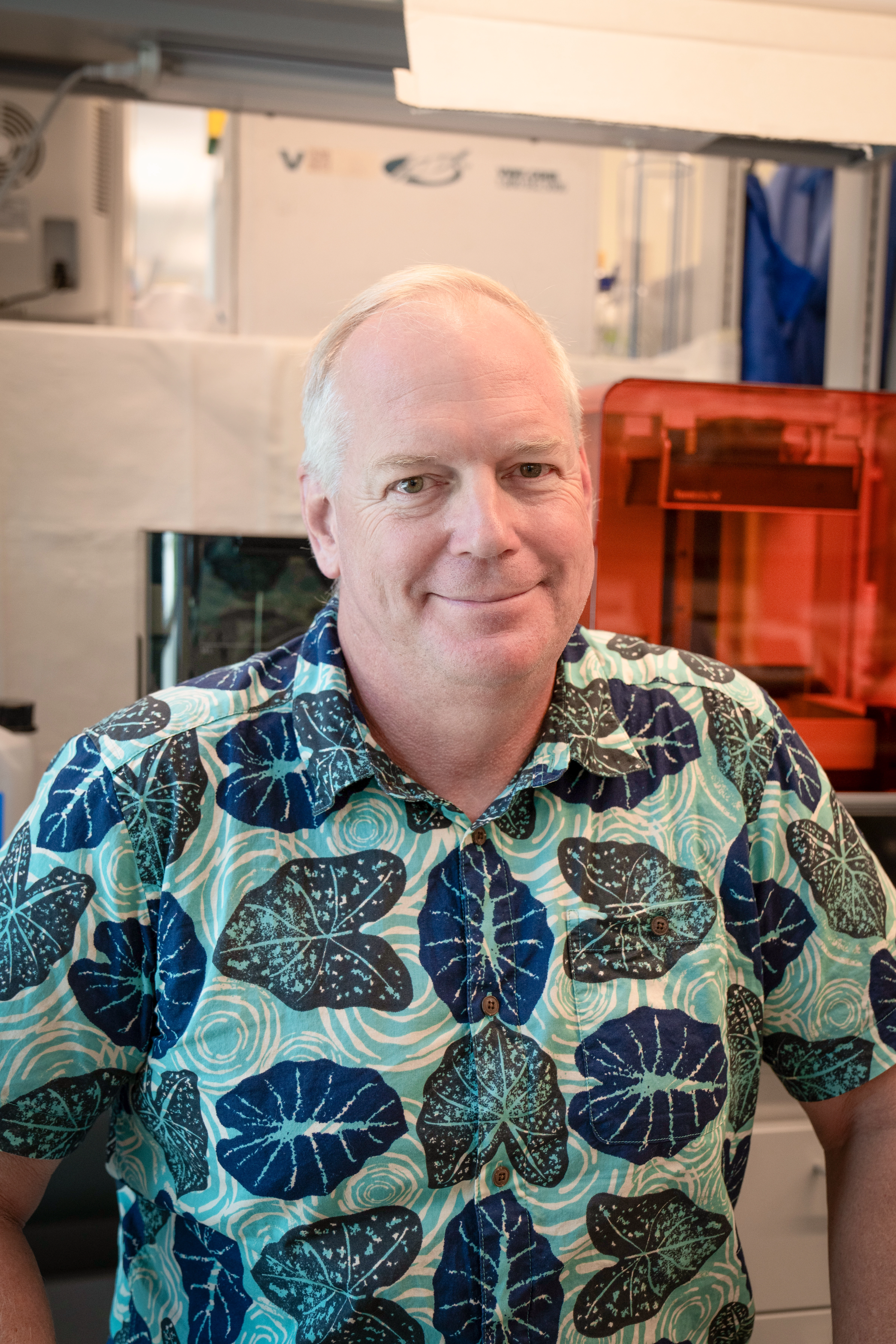When retired U.S. Army Colonel Dr. Jason Barnhill enters the laboratory doors at the University of Hawaiʻi John A. Burns School of Medicine, he carries along thirty years of active duty experience and a bold plan to save lives and keep soldiers safer on the battlefield.
Barnhill, associate professor in the department of cell and molecular biology at JABSOM says that after just over a year in his new position, “I'm really happy with where things are and really happy with where they're going, but it's still kind of in the early stages.”
The “early stages” involve a formal agreement between UH Mānoa and the Army’s Combat Capabilities Development Command Chemical Biological Center (DEVCOM CBC). Barnhill is teaming up with DEVCOM scientists to build organ-on-a-chip models through bioprinting to improve various treatments for burns, exposure to poisonous gases, antibiotic-resistant bacteria and other threats to soldiers in combat.

Imagine using a 3D printer to produce an organ but instead of using plastics, the printer uses “bio-inks” made up of different types of molecular biomolecules including collagen and other things that make up a cell’s extracellular matrix.
“ Basically we're trying to make tissue models, so models of human tissues and organs,” said Barnhill. “We plan to use these models for biomedical testing, instead of using animal models. Animal models have various drawbacks that we hope to avoid with our models. We will be using induced pluripotent human stem cells and to produce human tissue-like structures for multiple lines of research.”
He explains that reactions in human genomes are very distinct to those in “little white lab mice.” The big picture is that with organ-on-a-chip models, “you can then do biomedical research in a way that will be more relevant.” The new military partnership is significant, especially with the state’s central geographic location within the Pacific.
“ It's really critical that we develop bioprinting and other advanced manufacturing techniques here in Hawaiʻi because we're so isolated. We need to take advantage of every technological tool that will help us if there is a conflict,” Barnhill said. Adding that this technology will be useful to “not just Hawaii” but also for other islands in the Pacific. “Ideally we can build up our capacity and then be in a position to assist others.”
While the DEVCOM collaboration includes models for skin burns, Barnhill’s personal passion is to improve ocular health.
“I’m especially interested in the cornea, the outside of the eye and how we could make models of the cornea that could then be used to look at chemical exposure or infectious disease exposure,” Barnhill said. His fascination with the eyes stems from a hope to study and treat macular degeneration, a disease that runs in his family.
At this stage, he and his team are dreaming big when it comes to all the different possibilities and protections they could develop with these human-like models. The ideas would meet a very real military need.
“I've been tossing around the idea with some of my colleagues (at DEVCOM)… maybe being able to 3D print some type of contact lens or other thing that would be protective for the eye,” Barnhill said. “ Whether it's something that's worn prior to a chemical exposure or something that could be applied after to treat chemical burns there are some interesting possibilities for future work.
Barnhill’s path to UH began in the cold and dreary snow of upstate New York.
“I was in the infantry at the time, so we were out in it (snow) all the time,” said Barnhill. ”I wanted to live in Hawaiʻi and the idea of being able to do grad school (here) was really enticing.”
The chance arose in 2000, when the Army sent him to UH Mānoa to earn a masterʻs degree in biomedical sciences– an experience that sealed the deal for him. He found himself continuing to return to Hawaiʻi at every opportunity he could, whether it was to work at Tripler Hospital or to expand his knowledge and earn his PhD in cell and molecular biology.
After living in Hawaiʻi for about 12 years between the different positions at Tripler and as a graduate student at UH Mānoa, “Really, Hawaiʻi has become home for me and my family during that time.” Barnhill said. He returned to the East Coast in 2016 and eventually retired from the U.S. Military Academy West Point as its life science program director in 2024. “At that point I was like, you know, I want to get back to Hawaiʻi,” Barnhill said.
This summer, Barnhill is also mentoring undergraduate students through the IDeA Networks of Biomedical Research Excellence (INBRE) at JABSOM. Thanks to a partnership with Dr. Lester Smith at the Indiana School of Medicine, Barnhill’s interns will get hands-on experience using a bioreactor, a device used to cultivate living cells, to create retinal organoids.
“It’s similar to bioprinting in the sense you’re trying to push stem cells into a certain fate, but they’re just really small bundles of cells that act like organs. He is also hoping to spark collaborations across UH Mānoa, working with Dr. Tyler Ray at the UH College of Engineering, which has several bioprinting devices as well. Overall, Barnhill is overjoyed to be back in Hawaiʻi and excited for all the prospective innovations brewing at JABSOM.
“ Hawaiʻi's home for me now, so I want to help my home as much as I can,” Barnhill said. “I’m excited to have the chance to do this work that I think will be beneficial to both our service members and to the people of Hawaiʻi.”